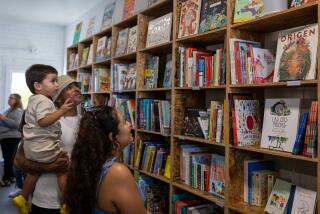After 100 Years, Sierra Madre Library Is Still a Gathering Place
- Share via
Robert Jenkins remembers the Sierra Madre Public Library of his childhood in the 1940s as “a kind of welcoming place. It was an odd cave of vast, cool spaces with tall, skinny windows. . . .”
Now head of the art department of Citrus College, Jenkins knows the 100-year-old library influenced his life, but finds it hard to describe just how.
“Perhaps it was more of a spiritual thing,” said the man who remembers it as “a gathering place in a town that always preened itself on having a literary element.”
In the 1980s, the Sierra Madre Library is still a gathering place and a source of civic pride. It was packed last Friday--scores of people were turned away--as the library continued the yearlong celebration of its 100th anniversary that began in January. Author Ray Bradbury was guest speaker. A sign that said “Sorry, we’re full” had been printed in advance.
The librarians always expect big turnouts for their programs, especially for those celebrating the centennial of one of the most popular places in town. About 200 residents usually attend, even for such simple pleasures as hearing hometown folks tell of their travels. As expected, Bradbury’s talk--in which he credited libraries for shaping his career--drew record numbers to a building that can hold 250 at most.
The original “somber, shadowy” building that Jenkins remembers was built in 1887 and replaced in 1956 with a modern brick-and-glass one on the same site at 440 W. Sierra Madre Blvd. The new building, like the old one, has a homey function that several Sierra Madreans call unique.
Sierra Madre, nestled in the foothills of the San Gabriel Mountains between Pasadena and Monrovia, has maintained a small-town character and size--a fairly steady 10,500 residents--for several decades. The library is near its small business district.
“People still bring their baskets of avocados and lemons to share, and librarians still get phone calls like ‘Tell my husband to pick up the cleaning on the way home,’ ” said Mary Tumilty, a librarian for 19 years before she retired two years ago.
Gordon and Elaine Rudolph, both former City Council members, remember their first visit to the library 25 years ago.
“We had to wait for a family of skunks to go by the front door, and the librarian said that was because she’d forgotten to turn on the light that usually scares them away,” Gordon Rudolph said. After perusing the shelves last week, he left with his usual armload of about 15 books and periodicals.
“If someone can’t get out of bed to get her own books, a librarian will select them and see that they are delivered,” assistant librarian Margaret Duran wrote in her booklet “A Centennial Celebration.” Other librarians said this kind of service is not unusual.
The Sierra Madre library was the 18th free public library to be built in California and the fourth in Los Angeles County. At that time, it was common for libraries to charge users annual fees or “subscriptions” to pay for books and salaries.
According to records in the California State Library, the Los Angeles and Pasadena libraries opened in the 1870s, and the Pomona library was built in 1887. The Sierra Madre Library is listed as a subscription service that began in 1886 and later became free to the public. It was one of the first libraries in the state to have its own building, in 1887.
Howard Wagner, president of Friends of the Sierra Madre Library, said the group has 457 members--one of the largest Friends groups per capita in Southern California. It raises about $24,000 a year for the library.
Head librarian Toni Buckner is working with a committee that hopes to make a proposal to the City Council for a new community room later this year.
While Sierra Madre doesn’t change much, she said, the library has difficulty keeping up with growing demands for all kinds of services, such as computers that people can use on the premises and videos, books on tape and works of art that are loaned.
What had been the community room long ago became a children’s library. The library board meets in the basement. The several programs each week almost always fill the place, making it impossible for other people to come in and browse.
A large centennial display that greets patrons at the entrance includes a watercolor painted by Jenkins, recalling a period around 1940 when he worked as a library page. It is a nostalgic picture, almost a cartoon, of librarians and patrons deep in thought.
“I think the people there ever since have been cut out of the same cloth,” Jenkins said. “In some ways, things haven’t changed.”
More to Read
Sign up for Essential California
The most important California stories and recommendations in your inbox every morning.
You may occasionally receive promotional content from the Los Angeles Times.










